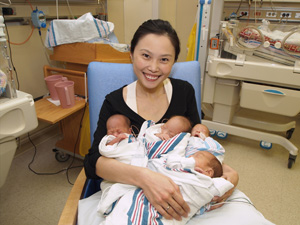January 10, 2011 - By Robert Dicks

Samantha Weng, who gave birth to four baby girls on Oct. 21, 2010, at Packard Children’s Hospital, underwent no fertility treatments.
“Well, it’s hard to know the exact odds, but it’s at least one in a million.”
Obstetrician Jane Chueh, MD, director of prenatal diagnosis and therapy at the Johnson Center for Pregnancy and Newborn Services at Lucile Packard Children’s Hospital, is talking about a naturally conceived pregnancy that led to the birth of quadruplets Audrey, Emma, Natalie and Isabelle Wang.
The preemie girls were born at 26 weeks gestation on Oct. 21, 2010, to parents Samantha Weng and Wayne Wang of Redwood City, Calif. Now close to their original due date after three months of intensive care, the girls are getting ready to head home to a busy and loving household and one really big minivan.
In the spring of 2010, Samantha and Wayne were excited to start a family, but never expected this. Remarkably, mom underwent no fertility treatments during the journey. “We thought we were having one, then ultrasounds showed two, then three, and then we found out about four,” said Samantha, whose family has no history of multiples. “We were shocked and then even more shocked. We were also very happy, but a bit overwhelmed.”
Fraternal quadruplets resulting from natural conception are very rare, occurring in only one in 729,000 births. But one of Samantha’s eggs split into two embryos – they became Audrey and Emma – thus upping the odds to over one in a million. (Doctors know the two are identical because they shared a placenta.)
“It’s too early to tell if the other girls, Natalie and Isabelle, are identical to each other,” said Chueh of the even rarer possibility of two sets of identical twins, “but if they are, the babies’ birth would be a one-in-8 million event. And if all four girls are identical, the odds would be one in 11 million or more.”
Earlier, when the pregnancy was at 11 weeks, Weng’s community physician had referred her to the expertise of Packard’s Perinatal Diagnostic Center and Center for Fetal and Maternal Health where a full range of diagnostic, treatment, consultation and counseling services are available.
“It was very high-risk,” said Chueh, who not only guided the pregnancy but also performed the cesarean delivery.
At 18 weeks, Samantha had early dilation of the cervix and pre-term contractions. Prolonging the pregnancy was critical, so Chueh placed the mother-to-be on bed rest during weeks 17 through 23. After that Weng became an inpatient at Packard Children’s through the birth of her babies at 26 weeks.
Fourteen weeks early and each weighing less than 2 pounds, the girls were immediately taken to Packard’s Neonatal Intensive Care Unit, where doctors and nurses specializing in preemies began tackling the babies’ respiratory and nutrition challenges and more.
“I was really worried about them,” said Weng. “It was pretty shocking even though we knew what to expect. They were so tiny and with all those tubes.”
Neonatologist Alexis Davis, MD, noted that the children progressed remarkably well in the NICU, a process started by a skilled delivery team.
“As usual, our neonatal intensive care doctors and nurses did an incredible job stabilizing the babies,” said Davis, “thanks to their experience dealing with high-risk newborns. This really gave the girls a good start.”
“This very complex case highlights the incredible range of pregnancy services we offer,” said Yasser El-Sayed, MD, associate chief of maternal-fetal medicine. “At Packard, Samantha was seen in our Perinatal Diagnostic Center, cared for in labor and delivery, hospitalized both before and after the birth of her babies, and followed up in our clinics. Meanwhile, the babies were just down the hall with the top neonatology specialists in the country.”
“It was a very emotional experience for everyone, and we’re thrilled with the outcome,” added Chueh. “We were successful because it was a remarkably committed family at a hospital that has extraordinary experience with high-risk pregnancies.”
Dad Wayne said the Packard team’s expertise was evident every step of the way. “The entire staff was wonderful in giving us the necessary medical information Samantha and I needed,” he said.
Considering the one in a million odds, and with Packard delivering 5,000 babies a year, this uncommon pregnancy should be seen again in, oh, about 200 years or so, right?
Well, maybe a little more frequently, especially considering the number of high-risk referrals the hospital receives. Packard delivered naturally conceived quadruplets to a San Mateo family in 2005, but those were three boys and one girl.
Robert Dicks is the director of media communications at Lucile Packard Children’s Hospital.
About Stanford Medicine
Stanford Medicine is an integrated academic health system comprising the Stanford School of Medicine and adult and pediatric health care delivery systems. Together, they harness the full potential of biomedicine through collaborative research, education and clinical care for patients. For more information, please visit med.stanford.edu.